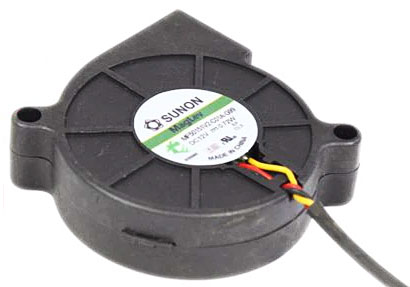

The Tesla Instrument Cluster (IC) in the Model S and Model X is a module that holds a 12.3” LCD display and associated electronics. It shows the vehicle’s speed, mode, time, temperature, battery range, and other details. For newer cars, it can also show a 360˚ view of the surrounding vehicles and key objects as you drive. We’ve identified 4 generations of the Instrument clusters. The Gen-1 and Gen-2 work with MCU1. While Gen-3 works only with MCU2. Gen-4 is exclusive to Palladium S/X LR/Plaid and uses a new module form factor. (Nov-2024 update)
Gen-1 Instrument Cluster For MCU1
This is the original IC, used in the first Model S. It is now discontinued, and the display and processor have not been manufactured in many years now.
Item |
Description |
|---|---|
| Part Numbers | 1004788-00-A to C |
| Status | Out of production, use Gen-3 |
| Compatible with | MCU1 |
| First Release | 22-Jun-2012 |
| Display | 12.3”; 1280 x 480 resolution |
| Display Type | LCD TFT; 256k Colors; LED Backlight |
| Display Vendor | Japan Display, Inc., Model TX31D06VM2AAA |
| Visual Compute Module | Nvidia Tegra Dual Core CPU, 512 KB DDR2 RAM, Tesla 1006072-00-A |
| Module Size | 12.6” W, 7.3” H, 2.1:” D (includes mounting tabs) |
| Weight | ~ 3 lbs. |
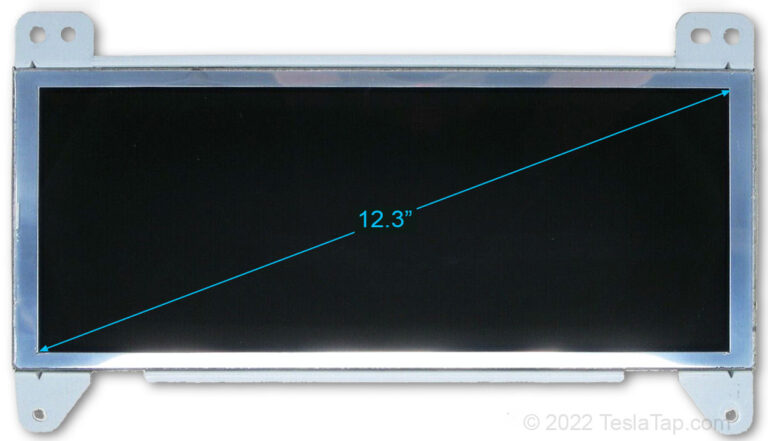
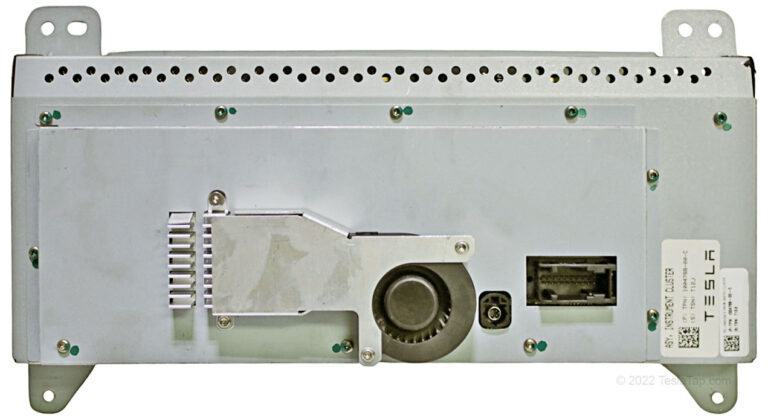
Gen-2 Instrument Cluster For MCU1
Gen-2 removed the fan, improved the display resolution and contrast, and jumped to 16M colors. We believe Gen-2 went into production in early 2014.
Item |
Description |
|---|---|
| Part Numbers | 1004788-00-D to H; 1039357-00-H |
| Status | Out of production, Use remanufactured 1039357-00-H |
| Compatible with | MCU1 |
| First Release | ~2014 |
| Display | 12.3”; 1920 x 1080 resolution |
| Display Type | LCD IPS; 16M Colors; 60 Hz; LED Backlight |
| Display Vendor | LG Display, Model LA123WF1-SL01 |
| Visual Compute Module | Nvidia Tegra Dual Core CPU, 1 GB DDR2 RAM, Tesla, 1038526-00-B |
| Module Size | 12.6” W, 7.3” H, 2.1:” D (includes mounting tabs) |
| Weight | 2 lbs., 12 oz. |
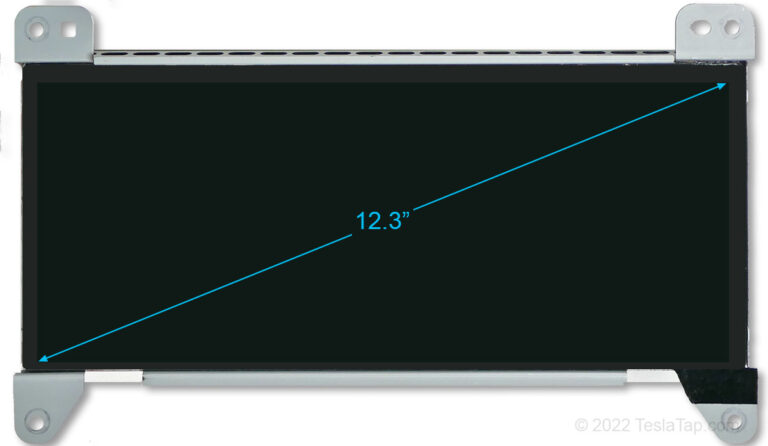
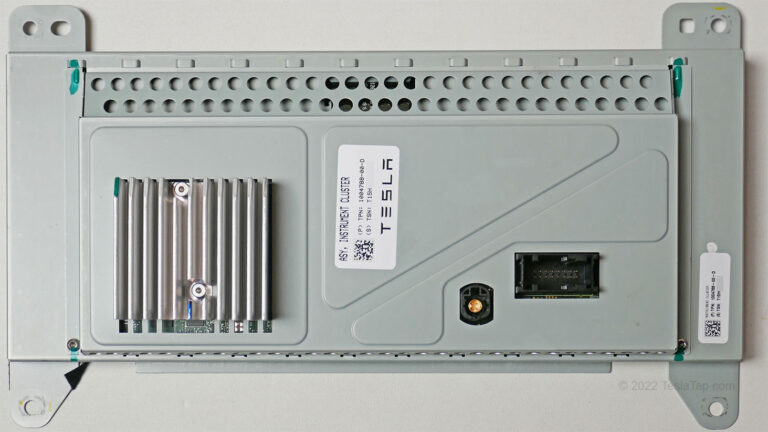
Gen-3 Instrument Cluster For MCU2
Gen-3 is very similar to Gen-2, but a speaker was mounted on the rear. The speaker is not electrically connected to the IC. The Gen-3 relies on MCU2 to operate.
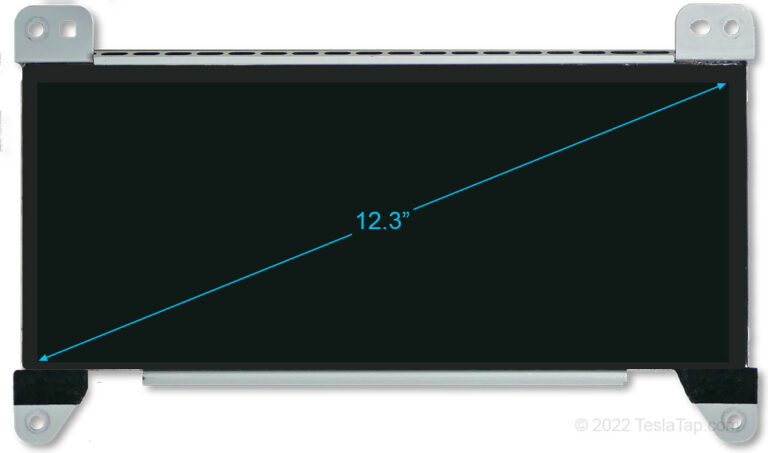
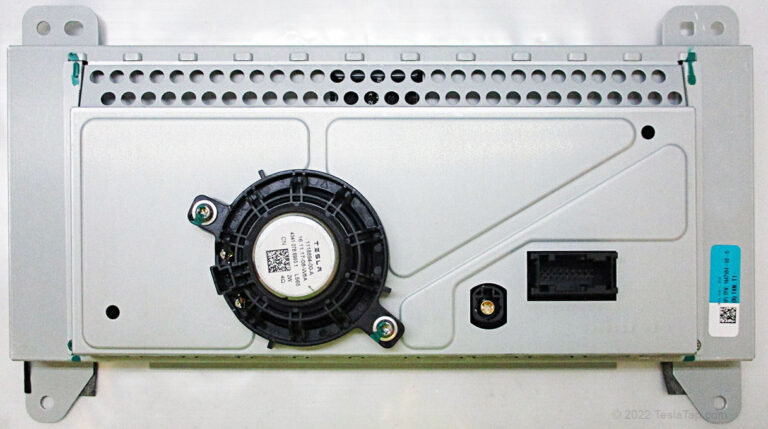
Item |
Description |
|---|---|
| Part Numbers | 1447934-00-E |
| Status | New and Remanufactured available from Tesla |
| Compatible with | MCU2 |
| First Release | ~1-Apr-2016 |
| Display | 12.3”; 1920 x 1080 resolution |
| Display Vendor | LG Display, Model LA123WF1-SL01 (Unconfirmed) |
| Display Type | LCD IPS; 16M Colors; 60 Hz; LED Backlight |
| Visual Compute Module | None (Unconfirmed) |
| Module Size | 12.6” W, 7.3” H, 2.1:” D (includes mounting tabs) |
| Weight | ~ 3 lbs. |
| Notes: | Includes a small separately wired speaker, not in Gen-1 or Gen-2. |
Gen-4 Instrument Cluster For MCUZ
Gen-4 uses an entirely new form factor and is specific to the Palladium Model S/X LR/Plaid. The connector is different than those used in earlier generations.
Item |
Description |
|---|---|
| Part Number | 1566110-00-D |
| Status | New, available from Tesla |
| Compatible with | MCUZ |
| First Release | 1-Feb-2021 |
| Display | 12.3”; 1920 x 1080 resolution |
| Display Vendor | Unknown |
| Display Type | LCD IPS; 16M Colors; 60 Hz; LED Backlight (assumed) |
| Module Size | Unknown |
| Weight | Unknown |


Connectors
Gen-1, Gen-2, Gen-3

The IC uses two connectors. The mating female jacks that are used to connect to the IC:
Ethernet connector X861
- HSD Fakra Z Female 4-pin (eBay has connectors and crimp terminals, or buy an assembled cable)
1 – TX+
2 – TX-
3 – RX+
4 – RX-
Power/CAN/Data X434
- Housing: TE Connectivity 1355348-1
- Terminals: TE Connectivity 5-928999-6
6 – CAN+, Chassis
7 – CAN-, Chassis
8 – Ground
13 – Wake (0V = Sleep, +12V = Wake)
17 – 12V Power
Gen-4
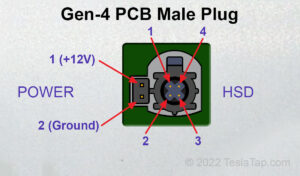
Power/Data
The Gen-4 IC uses a single connector. The mating female jack that is used to connect to the IC:
- Rosenberger 99K10D-1D5A5-Z Female Jack (unconfirmed, but very likely)
Pin 1 – 12v Power (actually 16v)
Pin 2 – Ground
HSD – Data, likely Ethernet the same as Gen-2/3 above (unconfirmed)
Fakra Connectors
Tesla uses a number of Fakra connectors, commonly used in the automotive industry. These appear in two basic types – one used for RF signals, such as connecting to antennas. The second type is HSD, High-Speed Data, and offers 4 pins and a shield for high-speed differential signals such as those used by Ethernet and LVDS camera data. The jack and plug lock together once mated. A thin tab in the center top of the jack must be depressed before the connector can be removed.
Fakra connectors can also include a key, so only the correct coded key fit in the connector. Key types include A through F and are color coded. For example, a white plug is a “B” key and only fits a white “B” jack. There is also a universal type “Z”, which is unkeyed and is in light blue. We specified the unkeyed “Z” connectors above as these are easier to obtain. We believe Tesla uses the black “A” keyed Fakra on all versions of the IC PCB.
With the Gen-4 IC, Tesla uses a modified Fakra connector with HSD+2. Two additional connections are available. With the IC, these are used to supply 16V power. This eliminates the second connector on older IC designs, saving both costs and installation labor.
Repair and DIY Fixes
Tesla
Tesla can replace your Gen-1 or Gen-2 IC with a Gen-3 unit. Unit cost and labor from Tesla have been running close to $1600. For those with MCU1 and a faulty IC, consider upgrading to MCU2, which includes a new Gen-3 IC. We haven’t found a price yet for Gen-4 IC, but the entire dashboard must be disassembled to access it, so the labor costs are going to be quite a bit higher.
The free Tesla service manual details removing and installing the instrument cluster. Sign up for a subscription.
Once logged in, Go to the vehicle’s service manual -> INFOTAINMENT -> Displays -> Instrument Cluster, for detailed instructions on removal and replacement along with photos.
Third Parties
Here are a few third-party companies that specialize in Tesla repairs and parts, often at a significantly lower cost than Tesla.
- EVFixMe, Costa Mesa, CA – IC & MCU repairs and screen replacements
- Gruber Motors, Phoenix, Arizona – IC & MCU repairs, screen replacements
- RealDeal EV, Tampa, Florida – IC & MCU repairs, parts, and screen replacements
- The Electrified Garage, Seabrooke, New Hampshire – IC & MCU repairs and screen replacements
Blower Fan
Only the Gen-1 Instrument Cluster has a fan. It can become noisy when the fan starts to fail. Replacement is fairly easy, once the IC unit is removed from the dash.
Tesla uses a 50x50x15mm blower style, 12V DC, 3-wire fan. The OEM part is Sunon MF50151V2-C01A-G99. It costs under $20, but may require ordering from China.
Replacement Parts
Here are the part numbers for internal parts. We do not expect Tesla will sell you the parts but it might be worth a try. It may be more useful if searching for a used part.
- LCD Display – Tesla 1004788-00-X (unconfirmed), LG Display LA123WF1-SL01 (Gen-2)
- Nvidia Virtual Compute Module, Tesla 1038526-00-B (Gen-2)
- Main PCB – 1006155-01-B (Gen-1); Tesla 1038525-00-B (Gen-2);
Replacement of the entire module, PCB, or the Nvidia VCM within the module requires a software redeploy. It is not plug-and-play as most PCs today with different hardware. A redeploy is done from Tesla’s Toolbox 3. If you don’t have access to Toolbox 3, Tesla offers a one month subscription for $500. Replacement of the same display type will not require a redeploy. You cannot use a Gen-2/3 LCD display on Gen-1 hardware as the LCD connectors are different, and the Gen-1 VCM has half the RAM as Gen-2.
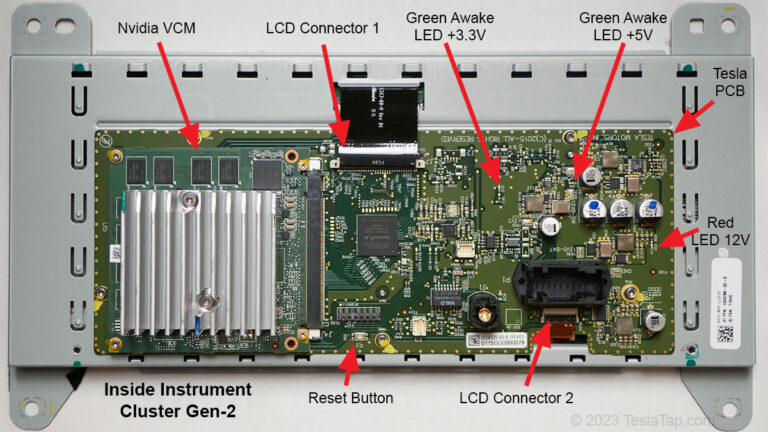
With +12V power applied, the red LED on the Tesla PCB will illuminate. With +12V applied to the Wake line, the +3.3V and the +5V green LEDs illuminate. These are partly visible when looking down into the enclosure on the bench but are not visible when the IC is mounted in the vehicle. When on the bench, applying power and activating the wake line will not illuminate the LCD.
LCD display used in IC Gen-2 and Gen-3
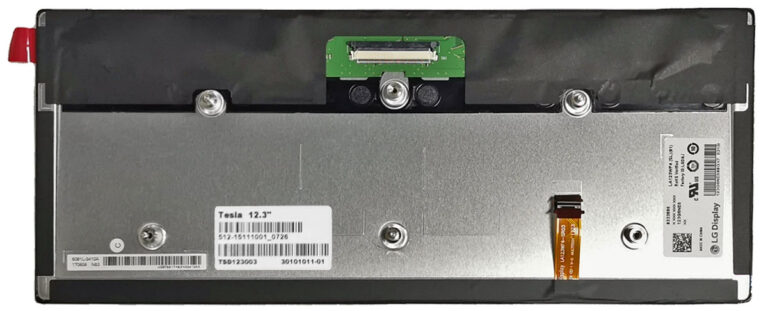
Screen Replacement Video
Display Bubbles and Goo Leakage
On Gen-2 displays, there is an extra layer on the LCD that we think was intended to improve the viewing angle slightly. On quite a few units, over the years, the seal on this secondary layer fails and the goo slowly leaks out. This has no effect on the operation but looks bad, especially when the display is off. We do not think the Gen-1 or Gen-4 displays have this issue. It’s less clear about Gen-3 or if LG Display improved the manufacturing at some point, but kept the same part number. Some have implied Tesla used a display not intended for the wide temperatures ranges encountered in vehicles, but the LG specifications show this display is rated for operation from -40°F to 185°F.
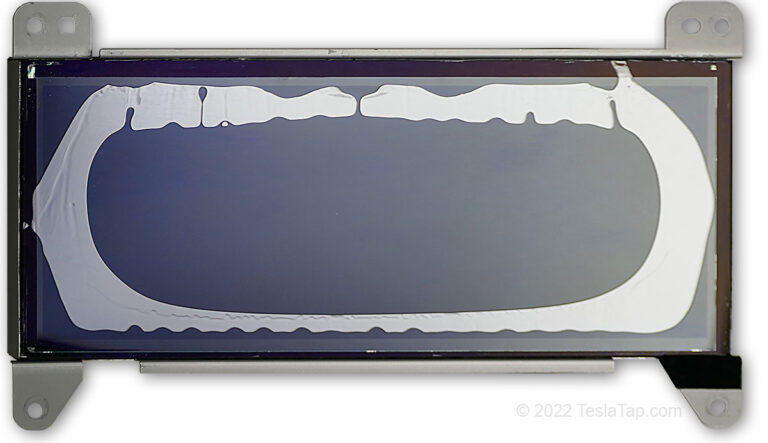
This example is one of the worst we’ve seen, and we photographed it in a way that makes far more visible than normal. Many users do not even notice the leakage or bubbles unless pointed out. Often only a few small bubbles appear near the top of the display.
The goo that seeps out is quite sticky but cleans easily with rubbing alcohol. Tesla recommends using IPA Wipes, which uses a 70% Alcohol and 30% water mix.
Here is one thread on TMC to remove the goo layer. It appears to require hours of work, and the display is very likely to be damaged in the process.
If you encounter the issue out of warranty (and we think all are out of warranty now), consider buying the MCU2 retrofit. It includes a new infotainment computer, LTE, and two new displays. The entire instrument cluster is replaced. We believe the new displays have been redesigned to eliminate the goo failures.
Software and Rooting
Linux
Gen-1, Gen-2 and Gen-3 instrument clusters use Linux to manage the display screen. This is a modified version of Ubuntu Linux. The source code is written in C++, and uses Qt for the graphical UI. Tesla makes open source portions available on GitHub’s repositories.
Rooting the Instrument Cluster
While it is was possible to root an IC prior to 2019.4 software, we don’t know any reason to bother. It will not gain access to any features or more interesting things in the MCU. A number of security enhancements Tesla has made over the years also make rooting exceptionally difficult now. We doubt more than 5 people in the world, if any, have rooted the IC.
Port Scan
The instrument cluster uses IP address 192.168.90.101 as of December 2022. It is possible Tesla may have used other IP addresses in the past and could change it in the future. We ran a port scan on a Gen-2 IC with the following results.
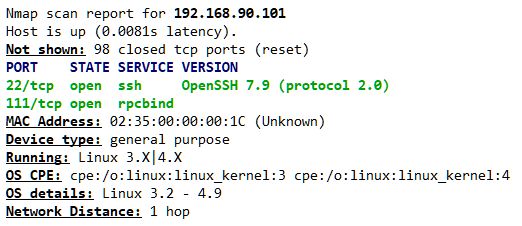
Gen-4
The Gen-4 instrument cluster has a different hardware design. We surmise the graphics are supplied from AMD’s graphics hardware in MCUZ, but still going through an Ethernet or custom data connection. The Gen-4 IC does not use an HDMI or Display Port connection to MCUZ.
Sources
- TeslaTap’s own teardown analysis and research
- Tesla’s Parts Catalog
- Tesla’s Service manuals
- Keen Security Lab
